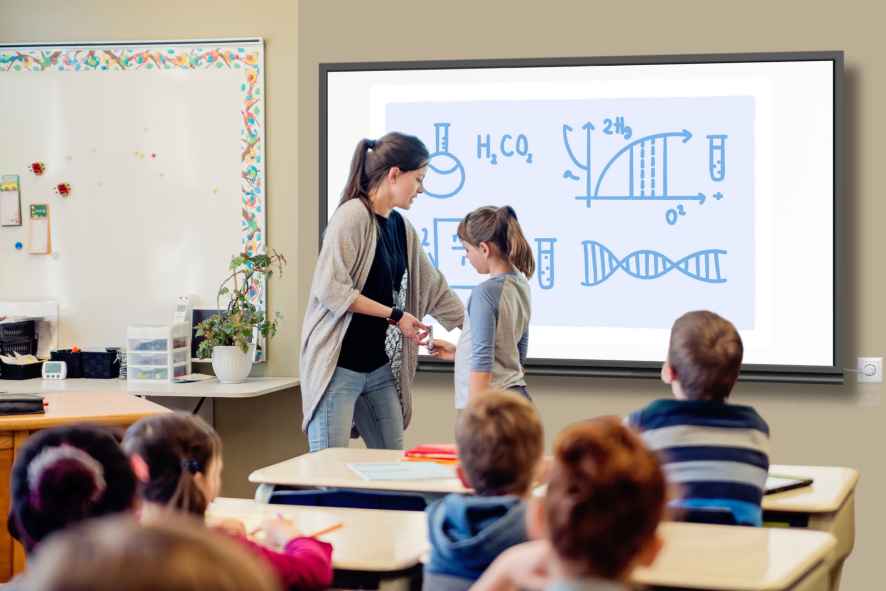Education has evolved dramatically in recent years, and technology plays a crucial role in making learning more engaging, interactive, and effective. Among the most impactful advancements is the interactive flat panel, a modern teaching tool that is transforming classrooms worldwide. Traditional chalkboards and whiteboards are making way for digital displays that foster collaboration, creativity, and real-time interaction. But how exactly do interactive flat panels enhance student engagement? Let’s explore the ways in which these dynamic screens are revolutionizing education.
1. A Hands-On Learning Experience
One of the biggest advantages of using an interactive flat panel in the classroom is the ability to provide a hands-on learning experience. Unlike passive learning, where students simply listen to a lecture, interactive technology allows them to actively participate in lessons.
- Students can touch, draw, and interact directly on the screen, making learning more engaging.
- The ability to manipulate digital objects in real-time fosters deeper understanding of complex subjects.
- Multi-touch functionality allows multiple students to collaborate simultaneously, encouraging teamwork and discussion.
With these capabilities, students become more involved in their learning process, leading to higher retention rates and increased enthusiasm for lessons.
2. Multimedia Integration for a Richer Learning Experience
Gone are the days of static, text-heavy lessons. With an interactive flat panel, educators can bring lessons to life using multimedia tools.
- Videos and animations help explain complex concepts in a visually appealing way.
- Interactive simulations allow students to experiment with scientific and mathematical models.
- Real-time quizzes and polls keep students engaged and provide instant feedback to teachers.
These features make lessons more dynamic and cater to various learning styles, ensuring that students grasp concepts more effectively.
3. Encouraging Collaboration and Peer Learning
Collaborative learning is a key component of modern education, and interactive flat panels facilitate teamwork effortlessly.
- Students can work together on problem-solving activities directly on the panel.
- Group discussions become more engaging with the ability to share documents, images, and ideas in real-time.
- Cloud connectivity allows students to access and edit projects from anywhere, fostering a culture of shared learning.
By promoting collaboration, interactive flat panels help students develop essential teamwork and communication skills that are valuable for future careers.
4. Boosting Student Confidence and Participation
Many students hesitate to participate in traditional classroom settings due to fear of making mistakes. However, interactive flat panels create a safe and engaging environment where students feel more comfortable expressing their ideas.
- Gamified learning elements, such as interactive quizzes and challenges, make participation fun and rewarding.
- Digital annotation tools allow students to write and erase effortlessly, reducing the fear of making mistakes.
- Teachers can track student progress in real time, offering personalized feedback to encourage growth.
By making lessons more interactive and inclusive, students feel more confident in their abilities and are more likely to engage in classroom activities.
5. Personalized Learning for Every Student
Every student has a unique learning style, and interactive flat panels allow teachers to tailor lessons to meet individual needs.
- Teachers can create customized lesson plans that cater to different learning speeds.
- Built-in accessibility features, such as text-to-speech and magnification tools, support students with learning differences.
- Recorded lessons allow students to review content at their own pace, reinforcing learning outside the classroom.
This level of personalization ensures that no student is left behind and that learning becomes more inclusive for everyone.
6. Real-Time Assessment and Immediate Feedback
Assessments are a crucial part of the learning process, and interactive flat panels provide instant feedback that helps students track their progress.
- Teachers can conduct live quizzes and polls to gauge student understanding.
- Real-time analytics help identify areas where students need additional support.
- Instant feedback allows students to correct mistakes immediately, reinforcing learning.
This interactive assessment method keeps students engaged and helps educators refine their teaching strategies.
7. Seamless Integration with Educational Technology
Today’s classrooms rely on multiple digital tools, and interactive flat panels seamlessly integrate with existing technology.
- Compatible with Google Classroom, Microsoft Teams, and other learning platforms.
- Can connect to laptops, tablets, and mobile devices for easy content sharing.
- Cloud-based storage allows students and teachers to access materials from anywhere.
This integration streamlines the learning process, making it more efficient and accessible for both educators and students.
8. Creating an Engaging Remote and Hybrid Learning Experience
As remote and hybrid learning become more common, interactive flat panels play a vital role in ensuring students remain engaged, regardless of location.
- High-quality video conferencing features enable real-time virtual lessons.
- Digital whiteboarding allows students and teachers to collaborate, even from different locations.
- Lesson recording features ensure that students can revisit lessons at any time.
This flexibility makes learning more accessible, bridging the gap between in-person and online education.
9. Encouraging Creativity and Innovation
Creativity is a crucial skill in today’s world, and interactive flat panels provide students with tools to express themselves creatively.
- Digital drawing and design tools foster artistic expression.
- Interactive storytelling apps encourage students to create their own narratives.
- STEM applications allow students to experiment with coding, engineering, and robotics.
By providing a platform for innovation, interactive flat panels inspire students to think outside the box and develop problem-solving skills.
Final Thoughts: The Future of Student Engagement
The traditional classroom is evolving, and interactive flat panels are at the forefront of this transformation. By enhancing engagement through hands-on learning, multimedia integration, collaboration, personalized education, and real-time feedback, these digital tools create an environment where students are more excited to learn.
For educators, embracing this technology means fostering a classroom that is not only interactive but also future-ready. Whether in traditional, remote, or hybrid settings, the interactive flat panel is shaping the future of education, making learning more dynamic, inclusive, and effective.
As schools continue to adopt these cutting-edge tools, the potential for student engagement and success will only continue to grow. The future of learning is here—are you ready to embrace it?
